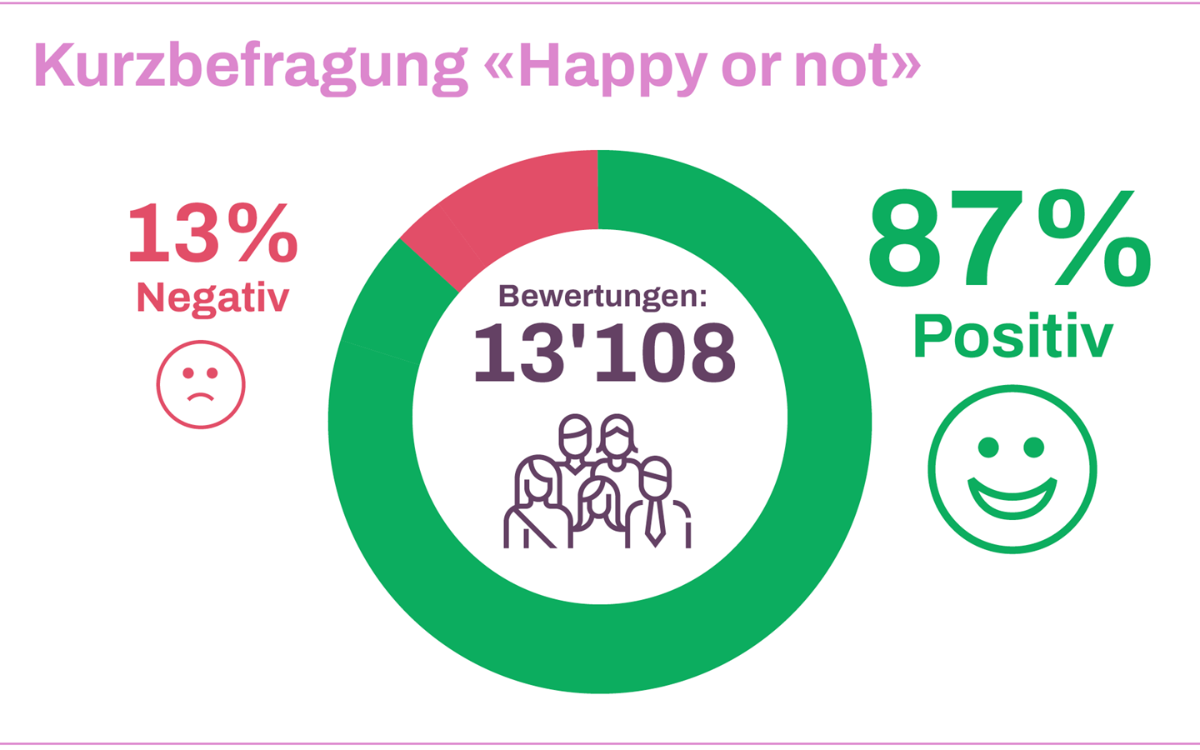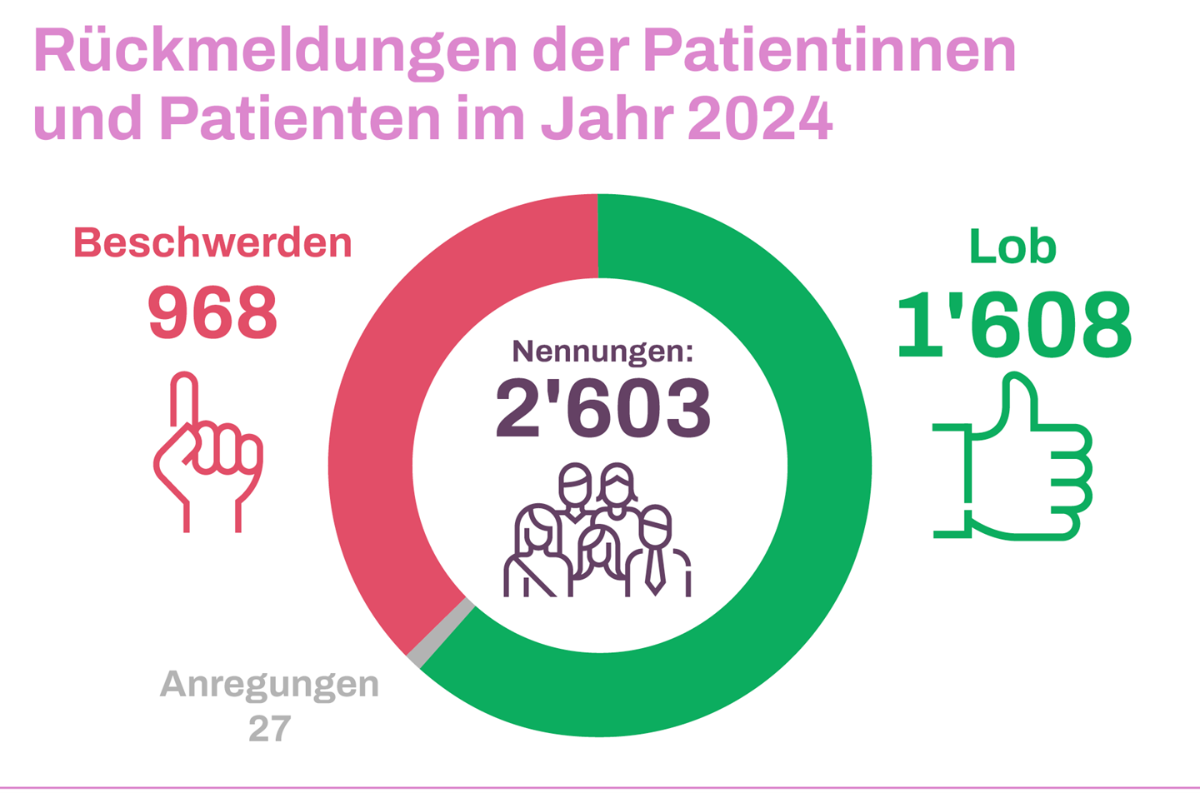
Patient opinion
Die Meinungen unserer Patientinnen und Patienten sind Gold wert
The University Hospital Basel records the opinions of patients using feedback management, the patient survey (PREMs) and with the involvement of the Patient Advisory Board.
Jump directly to the various topics here:
Feedback management
We have been offering patients and their relatives a central feedback management system at the USB since 2010. The implementation of a feedback management system required time, commitment and a willingness to continuously improve. Well thought-out and effective feedback management enables us to gain valuable insights that help us to optimize our performance.
By systematically recording feedback in quality management, clinics can ensure that they meet the needs and expectations of their patients, identify potential problems at an early stage and continuously improve their performance.
In 2023, we received 1,006 pieces of feedback. Patients passed on 2,665 concerns to us. This means that one piece of feedback can contain several aspects for different professional groups and/or disciplines as well as different subject areas. This can be praise, suggestions or complaints. These 2,665 concerns or mentions resulted in 1,736 praises and 878 complaints.
Feedback is processed in accordance with defined processes in collaboration with the respective responsible parties. Contact is made with all those who wish to provide feedback. If a statement is requested, this is sent to the sender of the feedback after clarification within the hospital. This underlines the USB's commitment to responding to feedback in a transparent and communicative manner. In addition, the respective departments receive their feedback immediately. This makes it possible to identify specific areas where improvements are required so that appropriate measures can be taken promptly.
Here are some important aspects and explanations of the process:
- Feedback collection mechanisms: Effective feedback management ensures that various channels are available for feedback.
- Analysis and evaluation: Feedback is analyzed and evaluated to identify trends, problem areas and opportunities for improvement.
- Response and measures: Based on the feedback analyzed, appropriate action is taken to address issues and initiate improvements. This may include revising procedures, training for employees, infrastructure changes or other interventions.
- Communication: Transparent communication is crucial to make the feedback process effective for all stakeholders. This includes communicating results, the status of improvement actions and valuing stakeholder feedback.
- Culture of continuous improvement: Feedback management is an important part of our culture of continuous improvement. This requires commitment at all internal levels. Feedback is taken seriously and opportunities for improvement are proactively sought.
New feedback flyer with QR code
We switched to paperless feedback at the end of 2023. The advantages are more efficient processes, less impact on the environment and easier access to data for analysis purposes.
Improvement measures day clinic
The day clinic on the 1st floor of Building C (formerly Clinic 2) was relocated to the first floor at the beginning of July 2023 to increase efficiency, where the majority of consultation hours already take place.
Patients and relatives have subsequently expressed their regrets about the move. Previously, they appreciated the familiar atmosphere, the daylight and the design of the rooms.
The room design was improved through optimization measures. For example, artificial light sources were used to create an almost natural daylight simulation. In addition, large-format pictures of calming natural landscapes such as forests or mountain scenery were hung up. These pictures give patients the feeling of being in nature and create a calming atmosphere.
Improved signage has also made it easier to find your way to the day clinic
Patient survey - inpatient and outpatient
How do patients experience the medical services, care and administrative processes during their inpatient or outpatient stay at the USB?
The realignment of the inpatient and outpatient survey, which was launched in 2023, paved the way for new surveys in terms of content and methodology.
The inpatient survey was relaunched as part of a pilot phase. Patients are surveyed exclusively digitally via e-mail. The USB has decided to introduce the scientifically sound and internationally proven survey tool "CPES-IC" with a focus on patient experience "PREMs".
In the outpatient areas, the patient survey was prepared as an intermediate phase in the form of a low-threshold and anonymous short survey using Happy or Not devices. This intermediate stage is necessary until the digital infrastructure and the survey methods and instruments for the forty or so outpatient clinics have been further developed.
We want to use the results of the surveys and feedback to tailor our processes and services to the needs of our patients in the best possible way. We have made the necessary preparations so that we can incorporate this data into quality development at the USB as part of a continuous improvement process (PDCA cycle) in accordance with the federal government's quality strategy.
Patient Advisory Board
In working groups and meetings, the members of the Patient Advisory Board regularly discuss specific topics and make recommendations. In this way, projects and developments can be better aligned with the needs of patients, their views can be taken into account and a patient-centered design of services and processes can be created together. Discussions can lead to solutions and insights for specific projects and quality developments in the hospital.
In 2023, the Patient Advisory Board supported the emergency center in obtaining certification as a "senior-friendly emergency center" by providing valuable feedback on the treatment experience of older people. In addition, patient views on signaling and accessibility were recorded in an on-site study and incorporated into the planning of the Campus Health generation project. The Patient Advisory Board was also involved in the preparation of the new patient survey.
Patient Advisory Board
In working groups and meetings, the members of the Patient Advisory Board regularly discuss specific topics and make recommendations. In this way, projects and developments can be better aligned with the needs of patients, their views can be taken into account and a patient-centered design of services and processes can be created together. Discussions can lead to solutions and insights for specific projects and quality developments in the hospital.
In 2023, the Patient Advisory Board supported the emergency center in obtaining certification as a "senior-friendly emergency center" by providing valuable feedback on the treatment experience of older people. In addition, patient views on signaling and accessibility were recorded in an on-site study and incorporated into the planning of the Campus Health generation project. The Patient Advisory Board was also involved in the preparation of the new patient survey.

Während die positive Bewertung der Behandlungsqualität unseren Qualitätsanspruch bestätigt, nehmen wir aber auch die kritischen Rückmeldungen ernst: Insbesondere wurde das Thema Wartezeit von Patientinnen und Patienten hervorgehoben. Diese Erkenntnisse fliessen direkt in unsere kontinuierlichen Verbesserungsmassnahmen ein.
Patient Advisory Board
In working groups and meetings, the members of the Patient Advisory Board regularly discuss specific topics and make recommendations. In this way, projects and developments can be better aligned with the needs of patients, their views can be taken into account and a patient-centered design of services and processes can be created together. Discussions can lead to solutions and insights for specific projects and quality developments in the hospital.
In 2023, the Patient Advisory Board supported the emergency center in obtaining certification as a "senior-friendly emergency center" by providing valuable feedback on the treatment experience of older people. In addition, patient views on signaling and accessibility were recorded in an on-site study and incorporated into the planning of the Campus Health generation project. The Patient Advisory Board was also involved in the preparation of the new patient survey.

